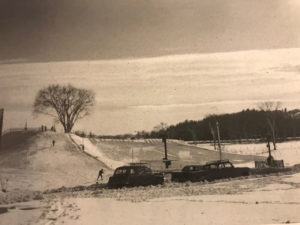By Karen D. Lorentz
Editor’s note: This is part two in a three-part series about the Rutland Region’s “lost” ski areas.
The formation of early ski areas was significant for driving the popularity of skiing and contributed to the post World War II ski boom of the 1950s and 1960s and the ensuing economic boost to the Rutland Region.
It was a tiny ski area with less than 32-foot vertical that had a huge impact on the world of skiing via its ski programs, but most ironically, this “lost” ski area at a college campus remains an unsung hero of early skiing.

Cars are parked near the slope as students head up the hill at Green Mountain College.
One of Vermont’s most successful early ski instruction programs was offered at Green Mountain College. It was started by the late William “Bill” Jenkins, Jr., who may be one of the most influential early ski instructors you have never heard of.
At a time when skiing was still largely considered a “man’s sport,” Jenkins taught thousands of young women to ski at the then women’s college and built the largest collegiate ski-school instruction program in the country on a rope tow hill with a 31-foot, 6.75-inch vertical!
Jenkins had learned to ski by watching and eventually getting lessons from Jack Durrance, brother of famous racer Dick Durrance. Jenkins grew up in Bellows Falls where he graduated from high school in 1941 and was a ski jumper. He served in the U.S. Army during World War II and graduated from Rutland Junior College in 1948. His ski-teaching career had begun when he taught German instructors who taught Americans on leave near Garmisch-Partenkirchen after the war. Returning to Vermont, he taught at Snow Valley while earning a college degree from Rutland Junior College in 1948.
Green Mountain College ski area
After graduation, Jenkins and his friend Bob Daniels started a ski school for Green Mountain College in 1948 at the nearby Marcy Farm in Hampton, New York. Busing students to the nearby farm, where he had installed a rope tow, was chaotic with students arriving hourly and having to find their equipment, so Jenkins decided to teach them on campus.
He created a north-facing hill by excavating a field and built “three slopes, each with a different gradient — for beginners, intermediates, and advanced skiers.” The hill was 300 feet long by 300 feet wide and had an electric rope tow. Later, there were three tows so three classes could be taught at the same time.
When it opened in 1951 it was likely the first custom-built ski hill on a college campus! The area operated from 1951 to 1975, and, in addition to 5,000 students learning there, local Poultney children were taught after school. There was night skiing three nights a week, thanks to floodlights Jenkins installed, and faculty members and locals were welcomed at no charge.
Jenkins also developed his own successful teaching system, incorporating whatever advances came along — Alois Mayer’s ski simulator, plastic mats, release bindings, fiberglas skis, Turfskis, bongo boards, his own innovative ski simulator, and snowmaking.
He even offered ski classes in the fall, first using regular skis on grass and then on plastic brush mats. In 1965 he switched to Turfskis, 33-inch plastic skis with three-inch wide rollers on the bottom. He also coached the college ski team, which he started circa 1953.
Jenkins emphasized making it easy for beginners “to learn to experience forward motion on skis, while learning how to snowplow and turn,” by attaching tow lines to a wide boom he had rigged up to a military surplus Jeep. Instruction was given by a teacher who sat on the back of the Jeep as it motored around a snow-covered field.
For the first years when snow was scarce Jenkins trucked it in. About 1955, he put in “the world’s cheapest and smallest snowmaking system. We had one nozzle and in three nights it could cover the hill,” he told me with a chuckle in a 2012 interview.
During his years at the college, Jenkins coached the school’s alpine ski team. The team trained on ten-gate runs on the small campus hill, practiced at other areas on weekends, and competed against powerhouse schools like Dartmouth and UVM, once winning the Bates Winter Carnival.
GMC student Debbie Mead became a freestyler and president of the Women’s National Freestyle Skiing Association. Eliza Sweeny Coleman, Class of 1976, made the Division II All East Alpine team, competed on the World Cup Free- style circuit, and was ranked fourth in the world overall (combined moguls, ballet, aerials) in 1979.
While Jenkins taught hundreds of students at six Vermont ski areas, he was most proud of his GMC program.
“We taught 5,000 students to ski,” he said. Over 28 years of continuous operation, it grew to be the largest college ski-school instruction program in the country, reaching 350 students per season at its peak.”
Jenkins also worked at High Pond Ski Area on weekends and vacation periods and later co-founded the Birdseye Ski Area, two of the last early influential ski areas for the Rutland Region.
In the next edition of the Mountain Times we’ll visit those areas.




